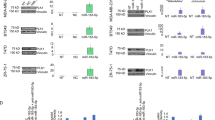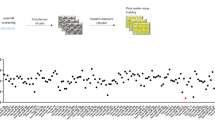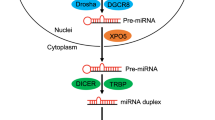Abstract
MicroRNAs (miRNAs) are endogenously expressed small non-coding RNAs, which are evolutionarily conserved and function as regulators of gene expression. These molecules are involved in numerous biological processes including differentiation, development, proliferation and apoptosis. Further investigation identifies that miRNAs may act as either potent oncogenes or tumor-suppressor genes, linking to cancer initiation and progression. Tumor necrosis factor (TNF)-related apoptosis-inducing ligand (TRAIL), as a member of the TNF family, is an attractive therapeutic target in cancer because it directly induces tumor cell apoptosis and has no cytotoxicity to normal cell types in vitro or in vivo. However, the resistance to TRAIL-induced apoptosis limits its clinical effectiveness. Interestingly, several studies convincingly demonstrate a role of miRNAs in modulating sensitive/resistant phenotypes to TRAIL. Here, we review the current findings about miRNAs involved in TRAIL-induced apoptosis in different cancers.
This is a preview of subscription content, access via your institution
Access options
Subscribe to this journal
Receive 12 print issues and online access
$259.00 per year
only $21.58 per issue
Buy this article
- Purchase on Springer Link
- Instant access to full article PDF
Prices may be subject to local taxes which are calculated during checkout
Similar content being viewed by others
References
Bartel DP . MicroRNAs: genomics, biogenesis, mechanism, and function. Cell 2004; 116: 281–297.
Carrington JC, Ambros V . Role of microRNAs in plant and animal development. Science 2003; 301: 336–338.
Lee Y, Kim M, Han J, Yeom KH, Lee S, Baek SH et al. MicroRNA genes are transcribed by RNA polymerase II. EMBO J 2004; 23: 4051–4060.
Cai X, Hagedorn CH, Cullen BR . Human microRNAs are processed from capped, polyadenylated transcripts that can also function as mRNAs. RNA 2004; 10: 1957–1966.
Denli AM, Tops BB, Plasterk RH, Ketting RF, Hannon GJ . Processing of primary microRNAs by the microprocessor complex. Nature 2004; 432: 231–235.
Lund E, Guttinger S, Calado A, Dahlberg JE, Kutay U . Nuclear export of microRNA precursors. Science 2004; 303: 95–98.
Yi R, Qin Y, Macara IG, Cullen BR . Exportin-5 mediates the nuclear export of pre-microRNAs and short hairpin RNAs. Genes Dev 2003; 17: 3011–3016.
Hutvagner G, McLachlan J, Pasquinelli AE, Balint E, Tuschl T, Zamore PD . A cellular function for the RNA-interference enzyme Dicer in the maturation of the let-7 small temporal RNA. Science 2001; 293: 834–838.
Ambros V . The functions of animal microRNAs. Nature 2004; 431: 350–355.
Lewis BP, Burge CB, Bartel DP . Conserved seed pairing, often flanked by adenosines, indicates that thousands of human genes are microRNA targets. Cell 2005; 120: 15–20.
Calin GA, Sevignani C, Dumitru CD, Hyslop T, Noch E, Yendamuri S et al. Human microRNA genes are frequently located at fragile sites and genomic regions involved in cancers. Proc Natl Acad Sci USA 2004; 101: 2999–3004.
Staszel T, Zapala B, Polus A, Sadakierska-Chudy A, Kiec-Wilk B, Stepien E et al. Role of microRNAs in endothelial cell pathophysiology. Pol Arch Med Wewn 2011; 121: 361–366.
Esquela-Kerscher A, Slack FJ . Oncomirs - microRNAs with a role in cancer. Nat Rev Cancer 2006; 6: 259–269.
Wiley SR, Schooley K, Smolak PJ, Din WS, Huang CP, Nicholl JK et al. Identification and characterization of a new member of the TNF family that induces apoptosis. Immunity 1995; 3: 673–682.
Walczak H, Miller RE, Ariail K, Gliniak B, Griffith TS, Kubin M et al. Tumoricidal activity of tumor necrosis factor-related apoptosis-inducing ligand in vivo. Nat Med 1999; 5: 157–163.
Ashkenazi A . Targeting death and decoy receptors of the tumour-necrosis factor superfamily. Nat Rev Cancer 2002; 2: 420–430.
LeBlanc HN, Ashkenazi A . Apo2L/TRAIL and its death and decoy receptors. Cell Death Differ 2003; 10: 66–75.
Kischkel FC, Lawrence DA, Chuntharapai A, Schow P, Kim KJ, Ashkenazi A . Apo2L/TRAIL-dependent recruitment of endogenous FADD and caspase-8 to death receptors 4 and 5. Immunity 2000; 12: 611–620.
Sprick MR, Weigand MA, Rieser E, Rauch CT, Juo P, Blenis J et al. FADD/MORT1 and caspase-8 are recruited to TRAIL receptors 1 and 2 and are essential for apoptosis mediated by TRAIL receptor 2. Immunity 2000; 12: 599–609.
Falschlehner C, Emmerich CH, Gerlach B, Walczak H . TRAIL signalling: decisions between life and death. Int J Biochem Cell Biol 2007; 39: 1462–1475.
Merino D, Lalaoui N, Morizot A, Schneider P, Solary E, Micheau O . Differential inhibition of TRAIL-mediated DR5-DISC formation by decoy receptors 1 and 2. Mol Cell Biol 2006; 26: 7046–7055.
Thorburn A, Behbakht K, Ford H . TRAIL receptor-targeted therapeutics: resistance mechanisms and strategies to avoid them. Drug Resist Updat 2008; 11: 17–24.
Koehler BC, Urbanik T, Vick B, Boger RJ, Heeger S, Galle PR et al. TRAIL-induced apoptosis of hepatocellular carcinoma cells is augmented by targeted therapies. World J Gastroenterol 2009; 15: 5924–5935.
Holoch PA, Griffith TS . TNF-related apoptosis-inducing ligand (TRAIL): a new path to anti-cancer therapies. Eur J Pharmacol 2009; 625: 63–72.
Garofalo M, Quintavalle C, Di Leva G, Zanca C, Romano G, Taccioli C et al. MicroRNA signatures of TRAIL resistance in human non-small cell lung cancer. Oncogene 2008; 27: 3845–3855.
Garofalo M, Di Leva G, Romano G, Nuovo G, Suh SS, Ngankeu A et al. miR-221&222 regulate TRAIL resistance and enhance tumorigenicity through PTEN and TIMP3 downregulation. Cancer Cell 2009; 16: 498–509.
Felli N, Fontana L, Pelosi E, Botta R, Bonci D, Facchiano F et al. MicroRNAs 221 and 222 inhibit normal erythropoiesis and erythroleukemic cell growth via kit receptor down-modulation. Proc Natl Acad Sci USA 2005; 102: 18081–18086.
He H, Jazdzewski K, Li W, Liyanarachchi S, Nagy R, Volinia S et al. The role of microRNA genes in papillary thyroid carcinoma. Proc Natl Acad Sci USA 2005; 102: 19075–19080.
Poliseno L, Tuccoli A, Mariani L, Evangelista M, Citti L, Woods K et al. MicroRNAs modulate the angiogenic properties of HUVECs. Blood 2006; 108: 3068–3071.
le Sage C, Nagel R, Egan DA, Schrier M, Mesman E, Mangiola A et al. Regulation of the p27(Kip1) tumor suppressor by miR-221 and miR-222 promotes cancer cell proliferation. EMBO J 2007; 26: 3699–3708.
Acunzo M, Visone R, Romano G, Veronese A, Lovat F, Palmieri D et al. miR-130a targets MET and induces TRAIL-sensitivity in NSCLC by downregulating miR-221 and 222. Oncogene 2012; 31: 634–642.
Birchmeier C, Gherardi E . Developmental roles of HGF/SF and its receptor, the c-Met tyrosine kinase. Trends Cell Biol 1998; 8: 404–410.
Tulasne D, Foveau B . The shadow of death on the MET tyrosine kinase receptor. Cell Death Differ 2008; 15: 427–434.
Incoronato M, Garofalo M, Urso L, Romano G, Quintavalle C, Zanca C et al. miR-212 increases tumor necrosis factor-related apoptosis-inducing ligand sensitivity in non-small cell lung cancer by targeting the antiapoptotic protein PED. Cancer Res 2010; 70: 3638–3646.
Condorelli G, Vigliotta G, Iavarone C, Caruso M, Tocchetti CG, Andreozzi F et al. PED/PEA-15 gene controls glucose transport and is overexpressed in type 2 diabetes mellitus. EMBO J 1998; 17: 3858–3866.
Renault F, Formstecher E, Callebaut I, Junier MP, Chneiweiss H . The multifunctional protein PEA-15 is involved in the control of apoptosis and cell cycle in astrocytes. Biochem Pharmacol 2003; 66: 1581–1588.
Condorelli G, Vigliotta G, Cafieri A, Trencia A, Andalo P, Oriente F et al. PED/PEA-15: an anti-apoptotic molecule that regulates FAS/TNFR1-induced apoptosis. Oncogene 1999; 18: 4409–4415.
Zanca C, Garofalo M, Quintavalle C, Romano G, Acunzo M, Ragno P et al. PED is overexpressed and mediates TRAIL resistance in human non-small cell lung cancer. J Cell Mol Med 2008; 12: 2416–2426.
Carriaga MT, Henson DE . Liver, gallbladder, extrahepatic bile ducts, and pancreas. Cancer 1995; 75 (1 Suppl): 171–190.
Johnstone RW, Frew AJ, Smyth MJ . The TRAIL apoptotic pathway in cancer onset, progression and therapy. Nat Rev Cancer 2008; 8: 782–798.
Stutes M, Tran S, DeMorrow S . Genetic and epigenetic changes associated with cholangiocarcinoma: from DNA methylation to microRNAs. World J Gastroenterol 2007; 13: 6465–6469.
Li Y, Tan W, Neo TW, Aung MO, Wasser S, Lim SG et al. Role of the miR-106b-25 microRNA cluster in hepatocellular carcinoma. Cancer Sci 2009; 100: 1234–1242.
Pogribny IP, Tryndyak VP, Boyko A, Rodriguez-Juarez R, Beland FA, Kovalchuk O . Induction of microRNAome deregulation in rat liver by long-term tamoxifen exposure. Mutat Res 2007; 619: 30–37.
Razumilava N, Bronk SF, Smoot RL, Fingas CD, Werneburg NW, Roberts LR et al. miR-25 targets TNF-related apoptosis inducing ligand (TRAIL) death receptor-4 and promotes apoptosis resistance in cholangiocarcinoma. Hepatology 2012; 55: 465–475.
Thomas LW, Lam C, Edwards SW . Mcl-1: the molecular regulation of protein function. FEBS Lett 2010; 584: 2981–2989.
Mott JL, Kobayashi S, Bronk SF, Gores GJ . miR-29 regulates Mcl-1 protein expression and apoptosis. Oncogene 2007; 26: 6133–6140.
Taniai M, Grambihler A, Higuchi H, Werneburg N, Bronk SF, Farrugia DJ et al. Mcl-1 mediates tumor necrosis factor-related apoptosis-inducing ligand resistance in human cholangiocarcinoma cells. Cancer Res 2004; 64: 3517–3524.
Fornari F, Gramantieri L, Ferracin M, Veronese A, Sabbioni S, Calin GA et al. MiR-221 controls CDKN1C/p57 and CDKN1B/p27 expression in human hepatocellular carcinoma. Oncogene 2008; 27: 5651–5661.
Louis DN . Molecular pathology of malignant gliomas. Annu Rev Pathol 2006; 1: 97–117.
Ohgaki H, Kleihues P . Population-based studies on incidence, survival rates, and genetic alterations in astrocytic and oligodendroglial gliomas. J Neuropathol Exp Neurol 2005; 64: 479–489.
Chan JA, Krichevsky AM, Kosik KS . MicroRNA-21 is an antiapoptotic factor in human glioblastoma cells. Cancer Res 2005; 65: 6029–6033.
Corsten MF, Miranda R, Kasmieh R, Krichevsky AM, Weissleder R, Shah K . MicroRNA-21 knockdown disrupts glioma growth in vivo and displays synergistic cytotoxicity with neural precursor cell delivered S-TRAIL in human gliomas. Cancer Res 2007; 67: 8994–9000.
Walter J, Honsek SD, Illes S, Wellen JM, Hartung HP, Rose CR et al. A new role for interferon gamma in neural stem/precursor cell dysregulation. Mol Neurodegener 2011; 6: 18.
Visted T, Enger PO, Lund-Johansen M, Bjerkvig R . Mechanisms of tumor cell invasion and angiogenesis in the central nervous system. Front Biosci 2003; 8: e289–e304.
Simpson L, Galanis E . Recurrent glioblastoma multiforme: advances in treatment and promising drug candidates. Expert Rev Anticancer Ther 2006; 6: 1593–1607.
Shah K, Tung CH, Yang K, Weissleder R, Breakefield XO . Inducible release of TRAIL fusion proteins from a proapoptotic form for tumor therapy. Cancer Res 2004; 64: 3236–3242.
Shah K, Bureau E, Kim DE, Yang K, Tang Y, Weissleder R et al. Glioma therapy and real-time imaging of neural precursor cell migration and tumor regression. Ann Neurol 2005; 57: 34–41.
Ovcharenko D, Kelnar K, Johnson C, Leng N, Brown D . Genome-scale microRNA and small interfering RNA screens identify small RNA modulators of TRAIL-induced apoptosis pathway. Cancer Res 2007; 67: 10782–10788.
Li X, Oghi KA, Zhang J, Krones A, Bush KT, Glass CK et al. Eya protein phosphatase activity regulates Six1-Dach-Eya transcriptional effects in mammalian organogenesis. Nature 2003; 426: 247–254.
Ozaki H, Nakamura K, Funahashi J, Ikeda K, Yamada G, Tokano H et al. Six1 controls patterning of the mouse otic vesicle. Development 2004; 131: 551–562.
Xu PX, Zheng W, Huang L, Maire P, Laclef C, Silvius D . Six1 is required for the early organogenesis of mammalian kidney. Development 2003; 130: 3085–3094.
Zheng W, Huang L, Wei ZB, Silvius D, Tang B, Xu PX . The role of Six1 in mammalian auditory system development. Development 2003; 130: 3989–4000.
Coletta RD, Christensen K, Reichenberger KJ, Lamb J, Micomonaco D, Huang L et al. The Six1 homeoprotein stimulates tumorigenesis by reactivation of cyclin A1. Proc Natl Acad Sci USA 2004; 101: 6478–6483.
Yu Y, Khan J, Khanna C, Helman L, Meltzer PS, Merlino G . Expression profiling identifies the cytoskeletal organizer ezrin and the developmental homeoprotein Six-1as key metastatic regulators. Nat Med 2004; 10: 175–181.
Imam JS, Buddavarapu K, Lee-Chang JS, Ganapathy S, Camosy C, Chen Y et al. MicroRNA-185 suppresses tumor growth and progression by targeting the Six1 oncogene in human cancers. Oncogene 2010; 29: 4971–4979.
Behbakht K, Qamar L, Aldridge CS, Coletta RD, Davidson SA, Thorburn A et al. Six1 overexpression in ovarian carcinoma causes resistance to TRAIL-mediated apoptosis and is associated with poor survival. Cancer Res 2007; 67: 3036–3042.
Lu Q, Lu C, Zhou GP, Zhang W, Xiao H, Wang XR . MicroRNA-221 silencing predisposed human bladder cancer cells to undergo apoptosis induced by TRAIL. Urol Oncol 2010; 28: 635–641.
Zaman MS, Chen Y, Deng G, Shahryari V, Suh SO, Saini S et al. The functional significance of microRNA-145 in prostate cancer. Br J Cancer 2010; 103: 256–264.
Pitti RM, Marsters SA, Ruppert S, Donahue CJ, Moore A, Ashkenazi A . Induction of apoptosis by Apo-2 ligand, a new member of the tumor necrosis factor cytokine family. J Biol Chem 1996; 271: 12687–12690.
Patron JP, Fendler A, Bild M, Jung U, Muller H, Arntzen MO et al. MiR-133b targets antiapoptotic genes and enhances death receptor-induced apoptosis. PLoS One 2012; 7: e35345.
Thorburn A, Behbakht K, Ford H . TRAIL receptor-targeted therapeutics: resistance mechanisms and strategies to avoid them. Drug Resist Updat 2008; 11: 17–24.
Acknowledgements
This work was supported by grants from the National Natural Science Foundation of China (81070422, 30871088), SRFDP of Educational Ministry (20100131110060).
Author information
Authors and Affiliations
Corresponding author
Ethics declarations
Competing interests
The authors declare no conflict of interest.
Rights and permissions
About this article
This article is cited by
-
Inhibition of USP1 enhances anticancer drugs-induced cancer cell death through downregulation of survivin and miR-216a-5p-mediated upregulation of DR5
Cell Death & Disease (2022)
-
CASC2/miR-24/miR-221 modulates the TRAIL resistance of hepatocellular carcinoma cell through caspase-8/caspase-3
Cell Death & Disease (2018)
-
MicroRNA-519a-3p mediates apoptosis resistance in breast cancer cells and their escape from recognition by natural killer cells
Cell Death & Disease (2017)
-
Survivin-targeting Artificial MicroRNAs Mediated by Adenovirus Suppress Tumor Activity in Cancer Cells and Xenograft Models
Molecular Therapy - Nucleic Acids (2014)



